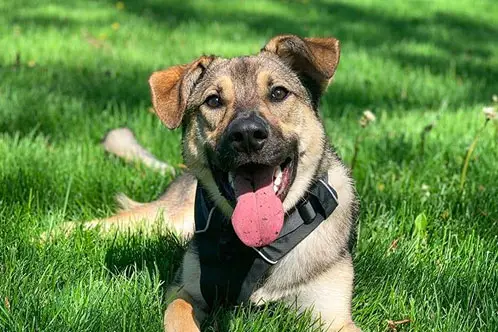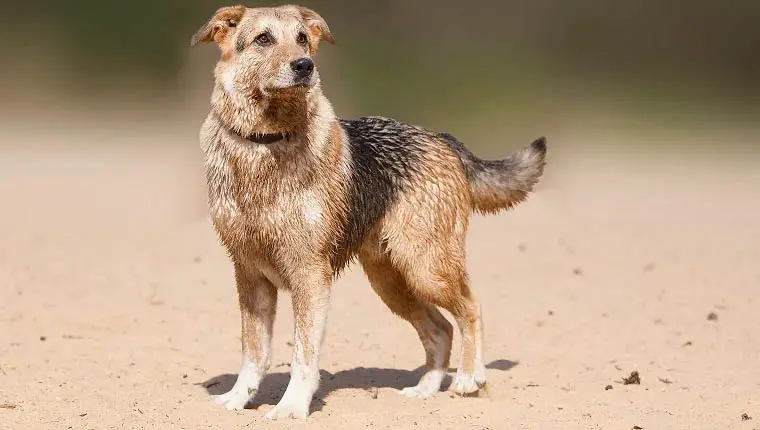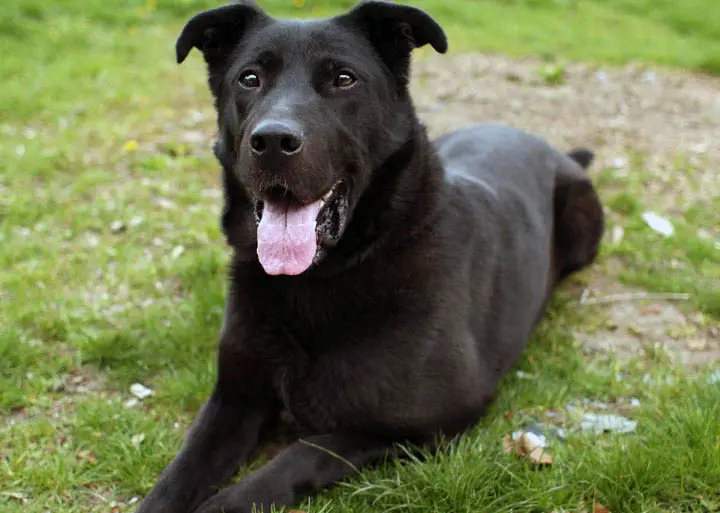The Sheprador - Everything You Need To Know About The Mix Of A Labrador And A German Shepherd
The German Shepherd is known for being an extremely active, intelligent, and intuitive dog and the Labrador is known for its intelligence, caring and loving nature so when we put these two incredible breeds together the result is a loving, protective, caring, and active dog. A precious, lovely animal!

The Sheprador is a family friendly medium-sized breed who’s looks can be a little hard to predict. When it comes to mixed breeds each puppy may have a little more or a little less of each parent so you can quite a big variance in appearance.
If you are thinking of adopting a crossbreed puppy between the German Shepherd and the Labrador, then this article is for you. We will break down the history of each parent breed and talk about the temperament, appearance, care, and training you can expect if you choose to bring a Sheprador into your home!
Origin Of The Sheprador
The Shephador is a beautiful medium-sized specimen, it is the cross between a Labrador and German Shepherd. Both parents are very popular in the United States and Europe, known for being excellent pets, active by nature, caring, and intelligent. They sound like the ideal pet, don't they?
The German Shepherd and the Labrador have completely different stories.
The German Shepherd is a dog from Europe, more specifically from Germany, just as its name implies. It is a relatively new breed, first seen in 1899 a breeding program was started to create a dog to protect herds of sheep from wolves.
Over time, thanks to their strength, obedience, and intelligence German Shepherds around the world became the preferred breed for many other types of work including military dogs, police dogs, and guard dogs.
Now, the Labrador was raised for the first time on a different continent: North America, on the island of Newfoundland in Canada.
The island of Newfoundland was a kind of fishing refuge from the United Kingdom in the seventeenth century, who carried auxiliary fishing dogs. Among these dogs was the ancestor of the current day Labrador.
These dogs had an extremely unique characteristic that favored them when swimming, allowing them to do so at a higher speed than the other dogs: Webbed toes! Labrador toes are joined by a membrane, somewhat similar to the fingers of a frog or a duck.
The English aristocrats were the ones who brought the Newfoundland dog back to England (thanks to their recognized passion for dogs) around 1825. They crossed it with different dogs and the result is know today as a Labrador.
The Labrador were used to hunt waterfowl and the Labradors of today still retain this characteristic. There gentle nature and intelligence has made them the favored breed as service dogs and they have become one of the most popular breeds of dogs in the world.
Physical Characteristics

One of the most important factors when deciding to buy or adopt a dog is to think about how big it will be when it is fully grown.
We already know that the German Shepherd and the Labrador are two breeds of dog that are anything but small and the cross between them will mature into a medium to large dog.
The Labrador, being a medium-sized breed, generally does not exceed 57 centimeters tall at the withers and the weight of the Labrador is about 30 kilograms.
While the German Shepherd is a larger dog with some males measuring up to 65cm’s at the shoulder. As for weight, they are generally between 25 - 33 kilos for females and 30 - 40 kg for males.
With the mix between these breeds you can expect a dog somewhere in the middle of these two height and weight ranges. If your puppy has more German Shepherd physical characteristics it will likely be on the large size of the middle and vice versa if it has more Labrador characteristics.
Both parents are strong and muscular breeds, so the mixture between both specimens will result in a healthy, active looking puppy that will reach medium to large proportions when it reaches adulthood.
What Color Are Shepradors?

It would be great if we could wave a magic wand to pick a color but when it comes to mixed breeds this is simply not possible. We can only predict colors based off of the parents but there are no guarantees.
Like any mixed puppy, the puppies of a German Shepherd and a Labrador may inherit a combination of their parent’s colors, or they may be more like mother or father.
Some cubs have a single solid color, however it is quite common for Shepradors to have darker faces and heads from their German Shepherd genes.
Regarding the colors that are most often seen (or "traditional" colors) the most common would be described as a Labradors coat with a darker face.
Coat Length
Not only can there be a difference in the color of our Sheprador puppy, we also have to think about what the length of the coat will be. Some Sheprador puppies inherit a short coat like a Labrador while others have a medium to long coat like the German Shepherd.
Chances are it is somewhere in between.
Both parent breeds have a double layered coat regardless of length so your Sheprador will have the same. This means that there is a smooth bottom layer of fur underneath with a rougher more sturdy top layer.
Temperament

When it comes to the temperament of a mix breed, we must take into account the temperament of the parent breeds, which in this case are the German Shepherd and the Labrador.
As we mentioned before, the German Shepherd is used for many jobs, but the most iconic job that comes to mind is that of a police dog.
This beautiful breed, with its athletic and proportionate body, has been controversial at times. These dogs have been bred to be protective and they have often be described as aggressive dogs that can attack for no apparent reason.
Obviously here at Total German Shepherd we strongly disagree with these stereotypes and know that a well brought up GSD is in no way aggressive or wild. German Shepherds are alert, intelligent, protective and wary of strangers. Proper early socialization is a must when it comes to GSD’s so they learn how to act and react around people and other pets.
While on the other hand, the Labrador is characterized by being a very kind affectionate breed. With an inquisitive and charming nature it is no real surprise why these dogs are some of the most popular breeds in the world.
So a Sheprador will likely be somewhere in the middle of these two breeds. You’re likely going to see the kindness of the Labrador and the intelligence and audacity of the German Shepherd all in one dog.
To ensure that your puppy is as loving, playful, as well as caring and protective as possible it is essential that the first months of their life are in contact with their siblings and their mother. Don’t adopt a puppy under the age of 8 weeks unless you absolutely have to.
After two months (which is the right age to be weaned) taking them for walks and introducing them to other pets and people. Socializing is very important in the early stages of a puppies development and this will help keep your adorable cross confident and sociable for the rest of its life.
Training
We already know that both parent breeds are very active: the German Shepherd has a protective instinct and loves to exercise, and the Labrador has its roots as a hunting dog.
Regardless of which parents your puppy takes after it is going to be an active pup. Your clever Sheprador puppy will require mental stimulation and will love to get out in the open and run like crazy!
A large backyard would be a good start for a Sheprador but that along won’t be enough. Your dog will love hiking and fetch and most of all it will love the water! Labradors are mad about swimming and your Sheprador will likely be no different.
Teach your Sheprador to fetch and you’ll have a great way to burn off some of your dogs energy and have loads of fun in the process.
Health
Health is very important for any dog, so our Sheprador should be taken to a trusted veterinarian for regular checkups. As a general rule a mix breed dog will be healthier than a purebred due to a larger breeding pool. It is however important to know common problems that arise in both parent breeds just so you can keep an eye out for them as your Sheprador grows and later reaches old age.
There are multiple canine ailments that afflict dogs, and one of them is hip or elbow dysplasia (or both), a very common disease in both German Shepherds and Labradors. Both parent breeds are prone to this disease so it is crucial to keep your Sheprador a healthy weight throughout it’s life so you don’t make the problem worse. Talk to your vet and see what they recommend for reducing the chances of hip dysplasia later in life.
With proper veterinary care, coupled with a good exercise program, love and quality food, we can expect a Sheprador mix to live for approximately 10 to 14 years.
Grooming
Your Sheprador is going to need their fur brushed at least once a week and potentially more if it has a coat length closer to a German Shepherd.
As the weather warms up you’re going to want to increase the frequency of brushings as your Sheprador will be shedding A LOT of hair. It is better to catch in a brush and chuck it in the bin than to clean it up off the floor, sofa, bed etc.
I would recommend brushing once or twice a day when your dog is in its shedding season
When it comes to dogs nails I taking them to a dog groomer to make sure that the nails are cut at the correct length. If you don’t know what your doing it is possible to cut too much nail off and hurt your dog.
Final Thoughts
A Sheprador is a medium sized active dog that loves being part of the family. If you have any experience raising dogs than a Sheprador should not be a problem. Make sure you keep them mentally and physically stimulated and socialize them well and you'll end up with a dog people dream of.
Sign up for promotions, news, discounts, and the chance to win prizes for you and your German Shepherd
